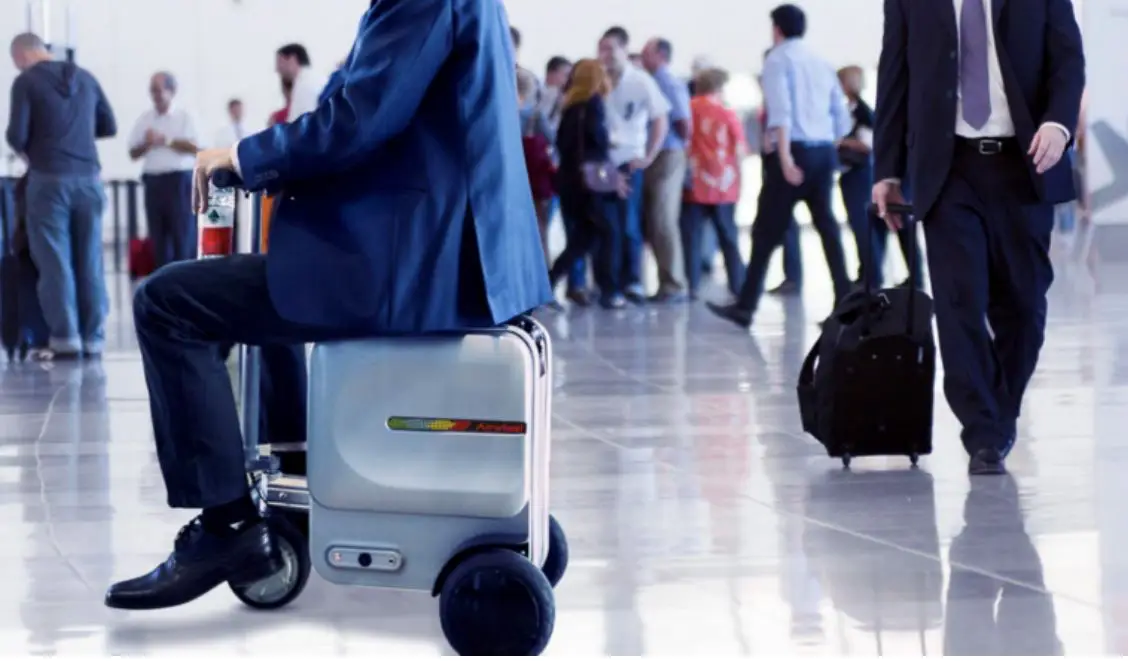Rideable electric or motorised suitcases, which emerged about 10 years ago, have become increasingly popular among travellers.
The global ride-on luggage market was valued at US$182m in 2021 and is projected to reach US$304m by 2031, according to Applied Market Research, a market research company.
These suitcases have a built-in scooter so instead of pulling your luggage behind you, you can ride on it and travel at a speed of up to 13 kph! That’s the equivalent of the average running speed for a moderately fit jogger.
The rideable luggage has also become popular with celebrities. K-pop stars Blackpink, Katy Perry, and Paris Hilton have all posted online videos of themselves riding their suitcases.
However, it is becoming a nuisance in some parts of Japan as more and more people are riding their suitcases around airports, train stations and on the streets.
Tokyo’s Haneda Airport in February banned the use of rideable suitcases in terminals to avoid collisions with other passengers. Narita International Airport in Tokyo also issued an advisory asking passengers in its terminals to monitor their surroundings due to the increased use of rideable suitcases. This advisory was due to complaints of these suitcases causing disruptions.
Chubu Centrair International Airport in Aichi Prefecture and Kansai International Airport in Osaka have also advised travelers not to ride them in their facilities.
Batteries must be removable
Airlines have also banned smart luggage that includes non-removable lithium-ion batteries which pose as a potential serious fire hazard in the aircraft cabin. An International Air Transport Association (IATA) spokesman said: “IATA member airlines prohibit the transport of luggage with non-removable lithium batteries.” Lithium batteries must not have a maximum capacity exceeding 160 watt-hours.
Usually a hard-shelled bag, smart suitcases have built-in electronic capabilities that include USB charging ports, smart locks, GPS tracking capabilities, Wi-Fi and hotspot connectivity, and even scales. The exact features vary from bag to bag.
Most airlines will allow smart luggage on their flights if the batteries can be removed. Just be aware of any weight restrictions. With the battery inside, the suitcase alone weighs about 12 to 13 kg.
Restrictions at airports
Restrictions vary by airport and country. In most American airports, rideable suitcases that are compliant with the rules of the Transportation Security Administration (TSA) and Federal Aviation Administration (FAA) are allowed in terminals with some restrictions for certain airlines. Since 2013, the FAA prohibits extra lithium batteries from being stored in an aircraft’s cargo unit. If passengers want to check-in rideable suitcases, they must first remove their lithium battery packs and carry them on the plane with them.
However, in airports across Canada, small lithium battery-powered vehicles are not allowed in both checked baggage or carry-on baggage.
In Singapore, the riding of suitcases is prohibited in Changi Airport for the safety of passengers and visitors. They can be used as carry-on or checked baggage by passengers if they meet a number of requirements, including having a removable battery.
Indonesian airports have also started to ban motorised suitcases as carry-ons and they must be checked-in minus the lithium battery. In Turkey, these suitcases can be carried onboard provided the battery is removed.
Non-removable batteries not allowed onboard certain airlines
Since 2018, United Airlines, Delta Airlines, Alaska Airlines, Southwest Airlines and American Airlines require that if you are traveling with a smart bag, the battery must be removable. If the battery cannot be removed, the bag will not be allowed on the aircraft. Qantas, Air Canada, British Airways and Ryanair also have similar policies.
Singapore Airlines is more strict. All small lithium battery-powered personal transportation devices including electric suitcases are prohibited BOTH as checked-in and hand-carry baggage. This is regardless of whether the battery can be removed from the device. Japan Airlines and Garuda Indonesian Airlines practise similar policies.
Some countries may impose additional prohibitions or restrictions on the carriage of specific items. These regulations apply on international flights, but aviation authorities in each region will have their own rules. In China, these are particularly strict. So please check with the respective airlines and airports if you wish to travel with your ridable luggage.
If you’re traveling in Europe, you’ll want to check with the European Union Aviation Safety Agency (EASA), or contact administrations in specific countries.
Strict restrictions on public roads
In June, a Chinese woman became the first person to be fined for riding a suitcase on a sidewalk in Osaka without a license. An Indonesian boy was stopped for riding a suitcase through the busy Dotonbori shopping area in Osaka in August. Japanese traffic laws classify rideable suitcases as “motorised bicycles”, which must be registered and equipped with a rear-view mirror and turn signals. Drivers are obligated to wear a helmet and have liability insurance.
In Singapore, motorised suitcases are categorised as personal mobility devices or e-scooters, and are therefore, not allowed on public footpaths or roads. In China, a woman was fined after traffic police caught her riding an electric suitcase down a busy Shanghai street on her way to work December 2023.
With the rise of usage of ridable suitcases, experts said that new laws will have to enacted in line with unexpected new forms of transport which will continue to emerge.















